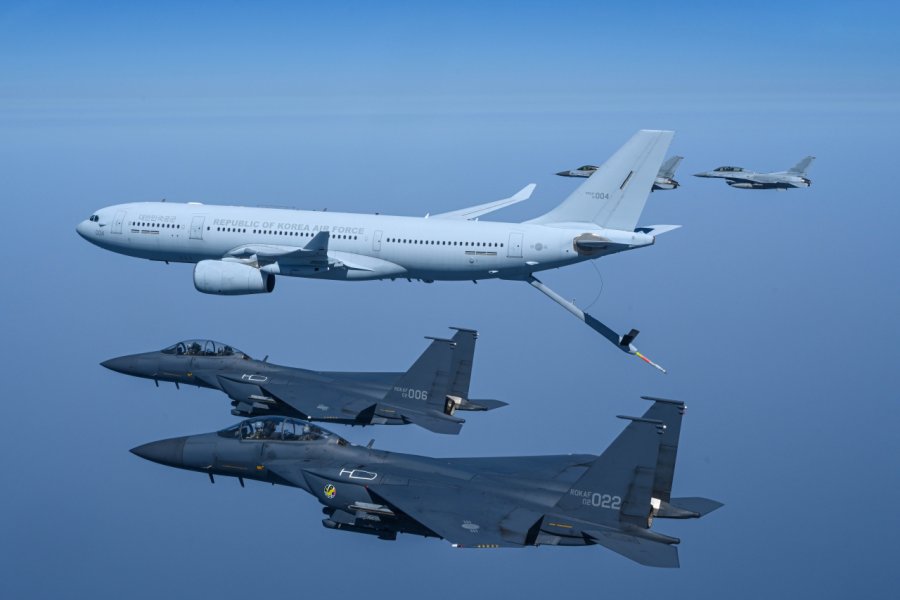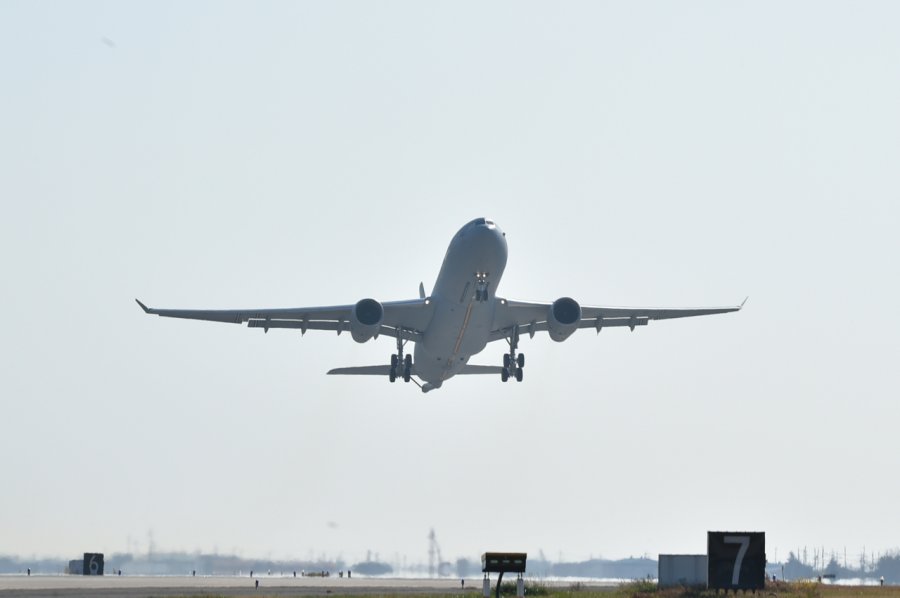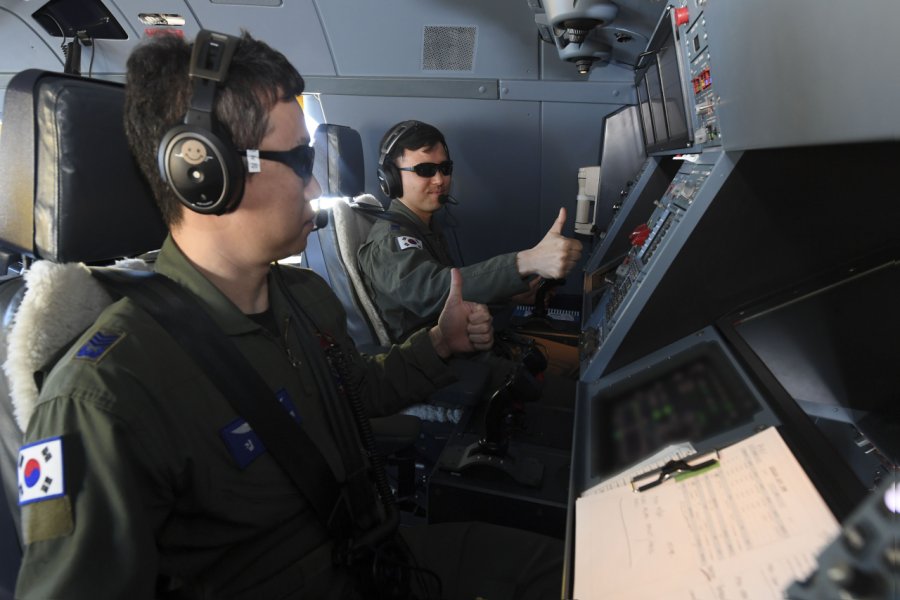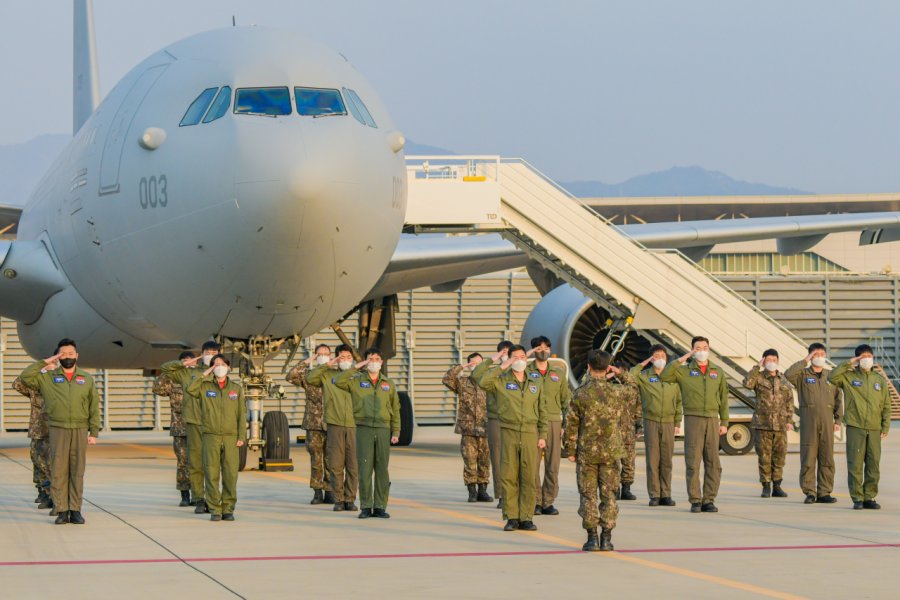April 18, 2023
SEOUL – “Refueling mission complete,” South Korean Air Force pilot Maj. Eum Ki-su announced aboard the KC-330 Cygnus tanker aircraft at 4,500 meters over the West Sea on Wednesday.
Fueling up fighter jets in the sky, a tricky maneuver that requires extending a pipeline into a fuel cap the size of a golf hole, is essential to reinforce the Air Force’s combat and war-fighting capabilities. Air-to-air refueling and tanking enable Air Force fighter jets to extend the range and time they can remain in the air as well as improve payload capacity, lethality and flexibility.
For instance, F-35A stealth fighters can now take off from an air base in South Korea while carrying more weapons and less fuel. Fighter jets can fly further north without making landings on their way to targets and carry out both air-to-air and air-to-ground missions longer in case of contingencies on the Korean Peninsula, according to the military.
A tanker aircraft, dubbed a “gas station in the sky,” is a critical force multiplier of air power, a weapon or equipment that can dramatically increase the effectiveness of a given force on the battlefield.

A KC-330 aerial tanker (center) of the South Korean Air Force flies alongside two F-15K (left) and KF-16 fighter jets (right) over the West Sea during an air-to-air refueling exercise on April 12. (Republic of Korea Air Force)
Airborne refueling is a process of quickly transferring flammable jet fuel from a tanker aircraft to a receiving aircraft mid flight. No aircraft needs to stop, but they need to fly very close at the same speed.
Around five minutes is needed for a KC-330 tanker aircraft to transfer 2,700 liters of fuel to a KF-16 fighter jet, while it takes five to 10 minutes to inject 5,400 liters to an F-15K fighter jet, Lt. Col. Cho Ju-young, commander of the 261st Air Refueling Squadron, said during an onboard briefing. One midair refueling extends endurance, or flying hours, of a fighter jet by one hour.
The KC-330 — which is capable of carrying about 111 metric tons of jet fuel — can refuel up to 15 F-35A stealth fighter jets or 10 F-15Ks, or 20 KF-16s in a single operation.

A KC-330 aerial tanker (center) of the South Korean Air Force extends a retractable pipeline, dubbed a “flying boom,” and flies along with two F-15K and KF-16 fighter jets over the West Sea during an air-to-air refueling exercise on April 12. (Republic of Korea Air Force)

A KC-330 aerial tanker of the South Korean Air Force refuels an F-15K fighter jet in midair on April 12. (Republic of Korea Air Force)
But aerial refueling is one of the most challenging and intricate air operations.
South Korean Air Force’s KC-330 multi-role tanker aircraft, dubbed Cygnus, took off from Osan Air Base in the city of Pyeongtaek, Gyeonggi Province, at 1:24 p.m. on April 12 for an aerial refueling of four fighter jets. Journalists were brought aboard the KC-330 military tanker to observe the training exercise for the first time.
The air-to-air refueling tanker flew for around 40 minutes and entered airspace designated for aerial refueling over waters off Mallipo Beach in the West Sea.
Then, the KC-330 tanker navigated the most suitable altitude for conducting refueling in light of weather and flying conditions. The KC-330 lowered and unfolded its flying boom, a rigid, retractable telescoping pipe that is extended and inserted into a receiving aircraft for refueling, at 4,500 meters in the air.
With the KC-330 flanked by two F-15K fighter jets and two KF-16 fighter jets, all aircraft were in position for aerial refueling.
One F-15K approached slowly toward the extended flying boom attached at the rear of the KC-330. Then, the KC-330 inserted the pipe into the F-15K’s tiny fuel cap, which is 10 centimeters in diameter, or the size of a golf hole.
During the 40-minute exercise, the aircraft flew at a distance of around 15 meters of each other and at the same speed of around 530 kilometers per hour.

An in-flight refueling specialist pumps jet fuel into a KF-16 fighter jet while controlling the position of a retractable pipeline attached to the rear underside of a KC-330 aerial tanker. (Republic of Korea Air Force)

An in-flight refueling specialist monitors the refueling process on a screen. (Republic of Korea Air Force)
Wearing polarized sunglasses, in-flight refueling technician Senior Master Sgt. Yoon Han-kyu operated the flying boom sitting behind a pilot in the cockpit while monitoring the process through footage transmitted in real time from cameras attached to the KC-330.
Among 65,000 Air Force personnel in South Korea, only 13 are trained boom operators.
“Pressure weighed heavily on me at first as I was obsessed with the thought that making even a small mistake during an aerial refueling operation can lead to a major accident,” Senior Master Sgt. Yoon said. The process requires total precision and control to make sure the metal arm boom doesn’t hit the receiving aircraft.
“But I’ve gained confidence and overcome the difficulties by continuing and repeating training.”
Since the first KC-330 tanker aircraft was deployed in January 2019, four KC-330s currently in operation have so far performed over 7,400 aerial refueling missions.
“Air Force pilots are always under pressure while flying aircraft carrying limited fuel. But aerial refueling frees them from this burden and enables them to fully display their abilities and maximize aircraft efficiency,” Lt. Col. Cho said.

A KC-330 aerial tanker of the South Korean Air Force stands on the tarmac at the Osan Air Base in the city of Pyeongtaek, Gyeonggi Province, before taking off for an aerial refueling mission on April 12. (Republic of Korea Air Force)

A KC-330 aerial tanker of the South Korean Air Force takes off from the Osan Air Base in the city of Pyeongtaek, Gyeonggi Province, to carry out an air-to-air refueling mission on April 12. (Republic of Korea Air Force)
The deployment of tanker aircraft — which enables Air Force fighter jets to enhance endurance, especially over remote areas — is also indispensable for South Korea to defend the country’s air defense identification zone, better known as KADIZ, against China and Russia.
Chinese and Russian warplanes have frequently violated the KADIZ, which encompasses the Dokdo islets, without prior notice. Chinese military aircraft breached the KADIZ about 70 times just last year.
Before the deployment of KC-330 multipurpose aerial tankers, KF-16 mainstay fighter jets were only able to conduct military operations over the disputed Dokdo islets — which are located at the easternmost edge of South Korea’s boundary in the East Sea — for 10 minutes.
KF-16 fighter aircraft performing military operations over Ieodo, a submerged rock south of Jeju Island, were limited to five minutes. Ieodo is squarely inside China’s unilaterally declared air defense identification zone.
Air-to-air refuelings, however, have enabled the South Korean Air Force to become more capable of conducting effective operations across the KADIZ.
Aerial refueling also has made the South Korean Air Force’s dream of global reach a reality.
South Korea’s Air Force took part in overseas military exercises without support from foreign forces in August 2022. Six KF-16 fighter jets received fuel from a KC-330 tanker aircraft en route to Australia to participate in the large-scale multilateral air combat exercise Pitch Black.
“We are very proud that aerial refueling has expanded operational areas of our Air Force beyond Korea and into the world,” Senior Master Sgt. Yoon said.
“Through repetitive training, we will do our best to provide support for air operations without being constrained by fuel limitations by further developing aerial refueling capabilities through repetitive training.”

In-flight refueling specialists give a thumbs-up to each other after completing their aerial refueling mission on April 12. (Republic of Korea Air Force)
South Korea initially recognized military requirements for tanker aircraft back in 1993, but the state-run arms procurement agency only approved the plan to purchase four tanker aircraft in 2013.
The four KC-330 tanker aircraft have also been used to carry out various missions for South Korea as well as the international community. It included transporting South Korean citizens from overseas countries hit by disasters and sending and bringing South Korean troops from and to places like the United Arab Emirates and Gulf of Aden in Somalia.
One KC-330 can fly up to 14,800 kilometers without landing if it doesn’t load any personnel or cargo, and it can transport up to around 300 passengers or 37 tons of cargo at maximum capacity.

South Korean Air Force personnel and a KC-330 tanker aircraft are dispatched to support quake-devastated Turkey with 118 rescue workers and relief supplies on Feb. 7. (Republic of Korea Air Force)
A KC-330 tanker aircraft was mobilized to carry more than 1 million doses of Johnson & Johnson’s Janssen COVID-19 vaccine from the US to South Korea in May 2021 and, in August the same year, carried out Operation Miracle, which brought 400 Afghans fleeing the Taliban-controlled nation to Korea.
The KC-330 was also sent to import urea water solution from Australia to ease a supply shortage of the key material used in diesel vehicles in November 2021.
This February, the KC-330 transported a team of 118 rescue workers and relief supplies to Turkey that had been ravaged by one of the deadliest earthquakes in recent history.


